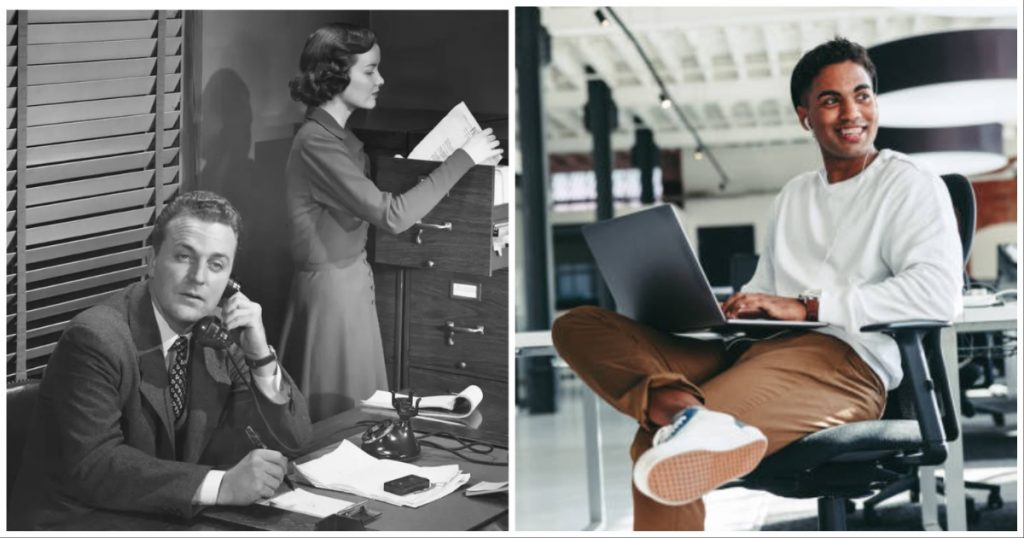Office wear has undergone significant transformations throughout the decades, reflecting the changing societal norms, fashion trends, and evolving work cultures. From the conservative and structured attire of the 1950s to the contemporary and flexible styles of today, office fashion has witnessed a remarkable shift. This article delves into the shifting office wear styles, highlighting popular trends starting from the 1950s and exploring the fashion choices for both men and women.

1950s: The Era of Formality and Elegance
The 1950s marked a period of formality and sophistication in office wear. Men predominantly wore suits, embracing tailored silhouettes, often paired with fedora hats and polished leather shoes. Double-breasted suits were prevalent, emphasizing a strong and authoritative appearance. Men would typically wear white dress shirts, often accompanied by conservative ties and pocket squares. This era symbolized an emphasis on professionalism and conformity.
For women, office wear was characterized by the iconic “New Look” popularized by Christian Dior. Women donned fitted, knee-length skirts with cinched waists, paired with matching blouses or sweaters. Jackets and blazers were also popular choices. Stockings and pumps completed the ensemble, projecting a refined and polished image.
1960s-1970s: The Rise of Individuality and Mod Fashion
The 1960s and 1970s saw a shift towards more individualistic and experimental office wear. Men’s fashion became more diverse, with the emergence of the mod culture. The slim-fitting suit, often in bold colors and patterns, became a staple for the fashion-forward man. The traditional suit and tie were occasionally replaced by turtlenecks and blazers, allowing for a more relaxed yet stylish appearance.
Women’s office wear also experienced a significant transformation during this period. The miniskirt became an emblematic garment, challenging conventional norms. Blouses with vibrant patterns and colors, paired with tailored jackets, became popular choices. The pantsuit gained traction as well, signifying a shift towards gender equality and empowerment in the workplace.
1980s-1990s: Power Dressing and Corporate Style
The 1980s and 1990s were characterized by power dressing, reflecting the growing prominence of women in the corporate world. Men’s fashion in this era was heavily influenced by Wall Street and corporate culture. The power suit became a symbol of authority, with shoulder pads and pinstripes being prominent features. Ties became wider and more colorful, adding a touch of personality to formal attire. The power suit was often complemented by polished leather shoes and briefcases, completing the corporate look.
Women’s office wear witnessed the rise of the “working girl” aesthetic. Shoulder pads and oversized blazers were in vogue, emphasizing strength and authority. Skirts were still popular, often paired with stockings and high heels. As women aimed to break glass ceilings, their attire became more assertive, with bold colors and structured silhouettes becoming the norm.
2000s-Present: Casualization and Flexibility
The turn of the millennium witnessed a significant shift towards casualization and flexibility in office wear. As work environments became more relaxed, traditional suits started to give way to business casual attire. Men embraced slimmer and more contemporary silhouettes, opting for dress pants paired with button-down shirts, often without ties. Blazers and sports jackets became staples, allowing for a blend of professionalism and comfort. It’s also not uncommon to see young employees mix streetwear with more formal clothing for a more relaxed look.
Women’s office wear also became more diverse and adaptable. Tailored pants and skirts remained popular, often combined with cardigans, blouses, or knitwear. The rise of dress codes like “smart casual” introduced more variety, enabling women to express their personal style while maintaining a professional appearance